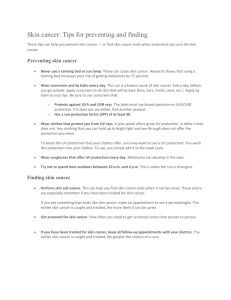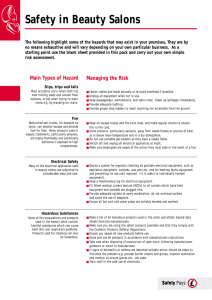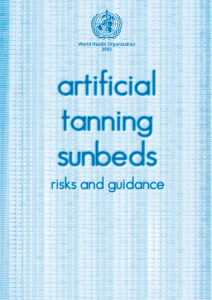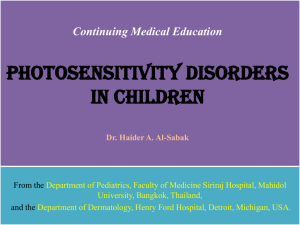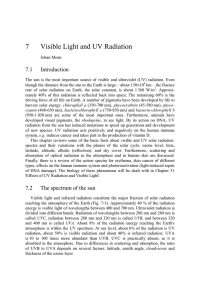The University of Reading Safety Office
advertisement
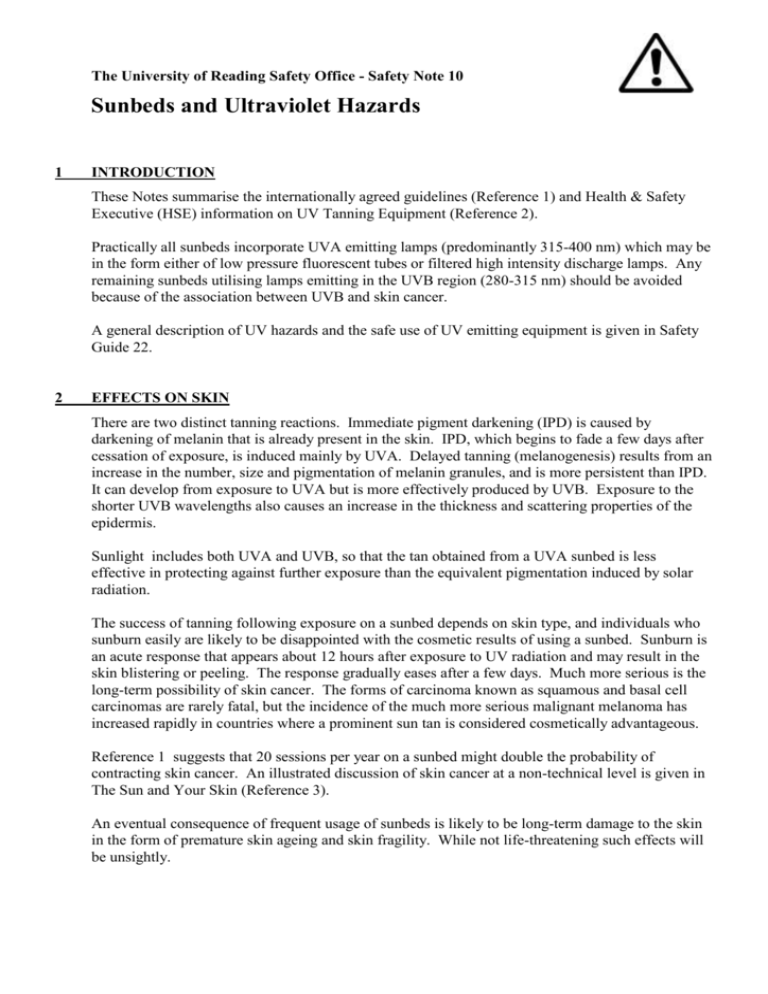
The University of Reading Safety Office - Safety Note 10 Sunbeds and Ultraviolet Hazards 1 INTRODUCTION These Notes summarise the internationally agreed guidelines (Reference 1) and Health & Safety Executive (HSE) information on UV Tanning Equipment (Reference 2). Practically all sunbeds incorporate UVA emitting lamps (predominantly 315-400 nm) which may be in the form either of low pressure fluorescent tubes or filtered high intensity discharge lamps. Any remaining sunbeds utilising lamps emitting in the UVB region (280-315 nm) should be avoided because of the association between UVB and skin cancer. A general description of UV hazards and the safe use of UV emitting equipment is given in Safety Guide 22. 2 EFFECTS ON SKIN There are two distinct tanning reactions. Immediate pigment darkening (IPD) is caused by darkening of melanin that is already present in the skin. IPD, which begins to fade a few days after cessation of exposure, is induced mainly by UVA. Delayed tanning (melanogenesis) results from an increase in the number, size and pigmentation of melanin granules, and is more persistent than IPD. It can develop from exposure to UVA but is more effectively produced by UVB. Exposure to the shorter UVB wavelengths also causes an increase in the thickness and scattering properties of the epidermis. Sunlight includes both UVA and UVB, so that the tan obtained from a UVA sunbed is less effective in protecting against further exposure than the equivalent pigmentation induced by solar radiation. The success of tanning following exposure on a sunbed depends on skin type, and individuals who sunburn easily are likely to be disappointed with the cosmetic results of using a sunbed. Sunburn is an acute response that appears about 12 hours after exposure to UV radiation and may result in the skin blistering or peeling. The response gradually eases after a few days. Much more serious is the long-term possibility of skin cancer. The forms of carcinoma known as squamous and basal cell carcinomas are rarely fatal, but the incidence of the much more serious malignant melanoma has increased rapidly in countries where a prominent sun tan is considered cosmetically advantageous. Reference 1 suggests that 20 sessions per year on a sunbed might double the probability of contracting skin cancer. An illustrated discussion of skin cancer at a non-technical level is given in The Sun and Your Skin (Reference 3). An eventual consequence of frequent usage of sunbeds is likely to be long-term damage to the skin in the form of premature skin ageing and skin fragility. While not life-threatening such effects will be unsightly. 3 OCULAR EFFECTS UV radiation can damage the front surface of the cornea, although the effects are principally confined to the shorter UV wavelengths that are no longer used for sunbeds. The consequence is an irritation that generally disappears within 48 hours. Although UVA is absorbed less in the lens than are shorter wavelengths it is believed that it can still initiate long-term damage in the form of loss of elasticity and browning. Paradoxically this browning, which causes absorption of the shorter wavelength light, results in a reduction of damage to the retina (which is behind the lens). All the above harmful effects can be prevented by the use of suitable, close-fitting, goggles. 4 OTHER HARMFUL EFFECTS 4.1 Photochemical reactions The harmful effects of UV radiation appear to be exacerbated by photochemical reactions with some lotions and creams that have been applied to the skin. Sunbed users should test the effects of such products by applying them only to a very small trial area of the skin. 4.2 Viral activation/acceleration There have been reports in the medical literature that UV radiation can in some circumstances activate and accelerate the growth of human viruses, particularly where the immune system is damaged. 4.3 Drug photosensitivity Drug photosensitivity means that an adverse effect is caused by the combined action of a drug and UV light. Effects may be caused by drugs taken systemically, or applied locally to the skin. Commonly used systemic drugs which can induce photosensitivity include the sulphonamides, the tetracyclines, oral contraceptives, the phenothiazines, and chlordiazepoxide (Librium). Substances which are applied locally and have been known to cause photosensitivity include various deodorants, dyes used in clothing, the juices of various plants, anti-microbials used in soaps, coal tar derivatives and, paradoxically, derivatives of para-amino benzoic acid which are used as sunscreens. There are two forms of drug photosensitivity: Photo Toxicity - This is the normal effect of too high a dose of ultra-violet light, but the threshold for toxicity is lowered by the drug. This effect occurs only whilst the drug is being taken. It is caused by the UVB spectrum of radiation and sunscreens can protect against it. Photo Allergy - This is an adverse effect which only occurs in some individuals and is not related to the dose of drug being used. Ultra-violet radiation causes a photochemical reaction in which the drug combines with tissue protein to form an antigen. This effect may persist after the drug is withdrawn. It is caused by radiation in the UVA spectrum. In view of the large number of common substances which may cause photo sensitivity those working with ultra-violet sources, should be aware of the possibility, and report any unusual reactions to the Occupational Health Medical Adviser at The University Occupational Health Service (extension 22-10). 5 RECOMMENDATIONS From the safety viewpoint the use of sunbeds for cosmetic purposes is not recommended and the following specific points should be noted. Sunbeds should not be used by persons: whose skin burns easily; with a large number of moles or freckles, or a family history of malignant melanoma; with extensive skin damage, pre-malignant or malignant skin lesions (in the case of other skin diseases medical advice should be taken); or who are children as they are believed to have enhanced sensitivity for malignant melanoma. Sunbeds should not be used if perfumes, body lotions or sprays have been applied that day. Persons who, despite the adverse effects, insist on acquiring an artificial tan, are recommended to take the following precautions: check that the lamps emit only the longer wavelength UVA and not UVB; begin with a very short session to check that the skin is not hypersensitive; and use close-fitting protective eyewear. As a general guide it is best not to exceed 20 sessions per year; and under no circumstances undergo more than 30 sessions a year 6 REFERENCES The following publications are available for perusal or loan from the Safety Office (extension 8888) or the University Radiation Protection Adviser (extension 8887). 1 Health Issues of Ultraviolet A Sunbeds Used for Cosmetic Purposes. A statement by the International Non-ionising Radiation Committee of the International Radiation Protection Association. Health Physics, 61 285-8 (1991) 2 UV Tanning Equipment, HSE Books, Sudbury, Suffolk, 1996 3 R Marks, The Sun and Your Skin, Macdonald, London, 1988 Lynne J Shaw University Radiation Protection and Safety Adviser 31 October 1997 Ref: NOT10Sunbeds3110.doc

